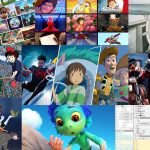The Art of Voice Acting in Cartoons: Voice acting in cartoons is an art form that brings animated characters to life, captivating audiences with distinct personalities, emotions, and unforgettable voices. Behind the scenes, talented voice actors play a pivotal role in creating the magic we see on screen. This article explores the intricate world of voice acting in cartoons, delving into the skills, techniques, and creativity that breathe life into animated characters.

The Evolution of Voice Acting in Cartoons:
Voice acting in cartoons has come a long way since the early days of animation. Initially, cartoons were often silent, relying on expressive visuals and music. The introduction of synchronized sound in the late 1920s marked a turning point, allowing characters to speak and enabling the emergence of voice acting.

In the golden age of animation, iconic voices like Mel Blanc, the “Man of a Thousand Voices,” became synonymous with beloved characters such as Bugs Bunny and Daffy Duck. As animation techniques evolved, so did the demands on voice actors, leading to a specialized profession requiring unique skills.
The Unique Challenges of Voice Acting:
Voice actors face distinct challenges compared to traditional actors. In a recording booth, without costumes, sets, or fellow actors, they must convey a character’s emotions and personality solely through their voice. Mastering this art requires a deep understanding of character development, storytelling, and vocal techniques.

One challenge is the ability to project emotions convincingly. Unlike on-screen actors, who can use facial expressions and body language, voice actors must rely solely on their vocal range, intonation, and pacing. They become the emotional conduit between the character and the audience, delivering performances that resonate on an auditory level.
Crafting the Voice: Techniques and Training:
Voice actors undergo rigorous training to refine their craft. They often work with coaches to develop diverse voices, accents, and tones. A key aspect is understanding the nuances of character psychology, as each voice must align with the animated character’s traits, quirks, and backstory.

Breathing life into a character involves more than just speaking lines; it requires creating an authentic and memorable voice. Many voice actors maintain a portfolio of distinct character voices, allowing them to transition between roles seamlessly. This versatility is a testament to their skill and dedication to the craft.
The Importance of Character Study:
Booming voice acting hinges on a deep understanding of the characters they portray. Before stepping into the recording booth, voice actors engage in extensive character study. They delve into the script, character descriptions, and storyline to grasp the essence of the animated persona.

Analyzing a character’s background, motivations, and relationships helps voice actors infuse authenticity into their performances. This preparation allows them to embody the character convincingly, capturing not only the words in the script but also the underlying emotions and personality traits that make the character unique.
Collaboration with Animation Studios:
Voice actors collaborate closely with animation studios and directors to ensure their performances align seamlessly with the visual elements of the cartoon. The process involves multiple takes, adjustments, and fine-tuning to synchronize voice and animation perfectly.

Directors are crucial in guiding voice actors to deliver performances that complement the visual narrative. They provide insights into the character’s context within the story, ensuring the voice actor’s interpretation aligns with the overall vision of the cartoon.
Voices Behind the Characters: Iconic Examples:

Mel Blanc: The Master of Versatility:
Mel Blanc, often hailed as the pioneer of cartoon voice acting, lent his voice to an astonishing array of characters. Blanc’s versatility sets the standard for future voice actors, from Bugs Bunny and Daffy Duck to Porky Pig and Tweety Bird.
Tara Strong: The Queen of Animated Voices:
Tara Strong has become a modern icon in the world of voice acting. With a career spanning multiple decades, she has voiced characters like Bubbles in “The Powerpuff Girls,” Twilight Sparkle in “My Little Pony,” and Harley Quinn in various animated projects. Strong’s ability to bring depth and uniqueness to her characters has made her a revered figure in the industry.

Mark Hamill: The Jedi of Voice Acting:
Renowned for his portrayal of Luke Skywalker in the “Star Wars” franchise, Mark Hamill has also carved a niche as a prolific voice actor. His rendition of the Joker in “Batman: The Animated Series” is legendary, showcasing his ability to transition from on-screen acting to the nuanced world of animated characters.

Grey DeLisle-Griffin: A Vocal Chameleon:
Grey DeLisle-Griffin is celebrated for her chameleon-like ability to adapt her voice to various characters. From Daphne in “Scooby-Doo” to Azula in “Avatar: The Last Airbender,” her vocal range has left an indelible mark on the animation landscape.
The Impact of Voice Acting on Character Popularity:
The success of an animated character often hinges on the effectiveness of the voice acting. A well-crafted voice enhances the visual portrayal and becomes inseparable from the character’s identity. Think of the instantly recognizable voices of characters like Homer Simpson, SpongeBob SquarePants, or Mickey Mouse – these voices contribute significantly to the character’s enduring popularity.
Voice acting can evoke emotions, create memorable catchphrases, and establish a lasting connection between the character and the audience. It transforms cartoons from mere visual spectacles into immersive storytelling experiences.

The Future of Voice Acting in Cartoons: Technological Advances:
As technology advances, voice acting in cartoons continues to evolve. Artificial intelligence and deep learning algorithms have opened new possibilities for synthesizing voices. While these tools offer efficiency and flexibility, they also raise questions about the authenticity and emotional depth that human voice actors bring to their performances.

However, the irreplaceable human touch in voice acting remains a cornerstone of its appeal. The subtle nuances, emotions, and improvisations that skilled voice actors bring to their roles add a layer of authenticity that technology struggles to replicate. As the industry embraces innovation, it also underscores the timeless artistry of human-driven voice acting.
Challenges and Opportunities in Voice Acting:
While voice acting is a rewarding profession, it comes with challenges. Intense competition, the demand for versatility, and the need to adapt to evolving industry trends can be daunting. Additionally, voice actors often face the challenge of maintaining vocal health, as extended recording sessions and the demand for diverse character voices can strain the vocal cords.

Conversely, the digital age has opened up new opportunities for voice actors. Online platforms, audiobooks, podcasts, and video games provide additional avenues for professionals to showcase their talents beyond the traditional realm of cartoons. The global reach of digital platforms has also enabled voice actors to connect with fans worldwide.
The Intersection of Animation and Voice Acting: Creating Timeless Classics:
The collaboration between animators and voice actors is at the heart of creating timeless animated classics. The synergy between a compelling visual narrative and a captivating voice performance elevates cartoons to the status of cultural phenomena. Think of classics like “Looney Tunes,” “Tom and Jerry,” or “Scooby-Doo,” where the perfect fusion of animation and voice acting continues to resonate across generations.

The ability of voice actors to adapt to different animation styles, from the slapstick humor of “Tom and Jerry” to the intricate storytelling of animated series like “The Simpsons,” demonstrates their versatility and impact on the medium.
Conclusion: The Enduring Magic of Voice Acting:
Voice acting in cartoons is an extraordinary craft that transcends the boundaries of animation. It transforms characters into cultural icons, leaving an indelible mark on the hearts and minds of audiences. Behind every animated character is a voice actor who breathes life into them, infusing personality, emotion, and authenticity.

As we continue to marvel at the animated worlds on our screens, let’s not forget the artists in the recording booths, the masters of vocal alchemy who turn scripts into symphonies of sound. The art of voice acting in cartoons celebrates creativity, storytelling, and the enduring magic that happens when a voice becomes inseparable from the character it embodies. It is an art form that transcends time, making us laugh, cry, and believe in the limitless possibilities of animated storytelling.
Read also
- The Art of Voice Acting in Cartoons: Breathing Life into Animated Characters
- Behind the Laughs: The Making of Comedy Cartoons
- A Comprehensive Look at the Cartoon Characters of DreamWorks Animation: Exploring the Whimsical World
- The Brain Cartoon: The Fascinating Evolution of a Cartoon Character
Frequently Asked Questions (FAQs) – The Art of Voice Acting in Cartoons: Behind the Characters
Q1: What is the role of a voice actor in cartoons?
A: Voice actors in cartoons bring animated characters to life through their vocal performances. They provide characters’ voices, convey emotions and personalities, and deliver dialogue that enhances the animated storytelling experience.
Q2: How do voice actors prepare for cartoon roles?
A: Voice actors prepare for cartoon roles by studying the character’s background, traits, and the show’s overall theme. They often work closely with directors to understand the nuances of the character and practice delivering lines with the right tone, emotion, and timing.
Q3: Can anyone become a voice actor for cartoons?
A: While having a unique and versatile voice is an asset, becoming a voice actor for cartoons requires skill, training, and dedication. Many successful voice actors undergo specialized training, participate in workshops, and build a diverse portfolio to showcase their abilities.
Q4: Do voice actors record together in the studio for cartoons?
A: In some cases, voice actors may record together in a studio to facilitate natural interaction and chemistry between characters. However, due to scheduling constraints, it’s common for voice actors to record their lines individually and later combine them during the animation process.
Q5: How important is versatility in voice acting for cartoons?
A: Versatility is crucial in voice acting for cartoons, as actors often portray various characters with distinct voices. Adapting to different tones, accents, and styles allows voice actors to take on various roles and contribute to the diversity of characters in animated productions.
Q6: What are some challenges faced by voice actors in cartoons?
A: Voice actors in cartoons may face challenges such as maintaining vocal health, creating unique character voices, and accurately syncing dialogue with animated mouth movements. Additionally, conveying emotions solely through the voice adds more complexity to their performances.
Q7: How do voice actors create distinct voices for multiple characters?
A: Experienced voice actors use various techniques to create distinct voices, including altering pitch, tone, and pacing and adding unique accents or speech patterns. This allows them to differentiate between characters and bring diverse personalities to the animated world.
Q8: Is there a specific age limit to pursue a career in voice acting for cartoons?
A: There is no specific age limit for pursuing a career in voice acting. People of various ages can enter the field if they possess the necessary skills and passion for the craft. Voice actors often succeed based on their talent and ability to connect with characters.
Q9: How can aspiring voice actors get started in cartoon voice acting?
A: Aspiring voice actors can start by building a demo reel showcasing their vocal range and versatility. Taking acting and voiceover classes, attending workshops, and networking with professionals in the industry are valuable steps. Online platforms may also offer opportunities for auditions and exposure.
Q10: Are there opportunities for voice actors in both traditional and digital animation?
A: Yes, voice actors have traditional and digital animation opportunities. With the growing popularity of streaming services and digital platforms, there is an increasing demand for diverse voices in animated content, providing voice actors with various opportunities in various formats.
This post was created with our nice and easy submission form. Create your post!





2 Comments